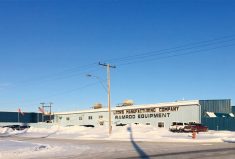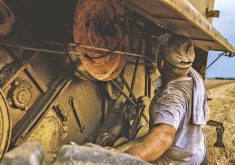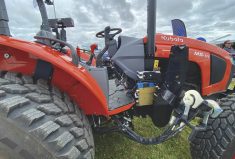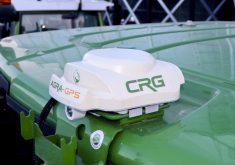Driven by high commodity prices and low interest rates, sales of farm equipment shot up last year — but getting delivery was a huge headache for many.
Sales of four-wheel-drive tractors in Canada rose 33 per cent, 100+ horsepower tractors were up 34 per cent, and combines were up 23 per cent, according to data from the Western Equipment Dealers Association.
And that was in a year when a host of issues — from microchip shortages to transport woes — were endemic.
Read Also

Moo translator and methane measures: There’s an app for that
Dalhousie University researchers use artificial intelligence to create new dairy farm apps that analyze cattle sounds and measure methane.
“So our sales could be better if we didn’t have supply chain issues,” said John Schmeiser, CEO of the equipment dealers’ association.
Farm equipment sales tend to go in cycles and the rise in sales was expected, he added.
“We had a peak in terms of equipment unit sales in 2014, and then from 2015 on to 2019 we were in that valley,” said Schmeiser. “At the end of 2019, we were coming out of the valley and the industry was going to take off. The manufacturers were advising dealers that they were going to be ramping up production, and then the pandemic hit.”
There have been “incredible” investments made to resolve supply chain issues, but the problems will persist for another year, he said.
“Depending on the manufacturer and depending on the product line, we are now seeing some tractors that were promised in April or May of 2021 finally being delivered to dealers,” he said. “In conversation with air drill manufacturers, they are telling us the situation is better today than it was a year ago. Is it pre-pandemic conditions? Absolutely not.”
Dealers are in daily conversation with manufacturers about delivery dates so they can keep their farm customers abreast of what’s happening, said Schmeiser.
The challenge of getting new equipment, coupled with the economic hit from the drought, means many producers are running older-than-usual machines — and that’s raised fears that parts won’t be readily available if there’s a breakdown during the crunch time of seeding or harvest.
But the situation has improved significantly, he said.
“Perhaps one of the biggest impacts the pandemic had on the industry was parts availability,” said Schmeiser. “We saw the manufacturers, again, right across the board, their parts fill rates dipped below acceptable standards from their parts depots.
“But for the most part, the worst of those problems are behind us now, and the reports we’re getting from dealers and manufacturers are the fill rates are improving.”
According to Alberta law, equipment manufacturers are required to have parts available for at least 10 years after the model year, he noted.
“There’s still a huge parts opportunity for anything that’s older than 10 years, and that’s why a lot of stuff is readily available,” he said. “The biggest issue, though, is that we’ve had some of the parts suppliers, some of those vendors for the manufacturers have gone out of business, and it’s left to the manufacturers to scramble to find replacement parts to meet that 10-year requirement.”
Many of the parts used by manufacturers to assemble machines come from overseas, said Jim Wood, chief sales and operations officer with Calgary-headquartered Rocky Mountain Equipment, the largest CNH (Case New Holland) dealer on the Prairies.
His company put in parts orders earlier than normal to ensure it had enough on hand, he said.
“We saw this coming in January 2021,” said Wood. “It’s not as bad as you would think. What CNH is trying to do is hold as many replacement parts for replacement parts, rather than use them in manufacturing.
“They must have so much available for machines down. I think that does cause a bit of delay in our equipment deliveries, but we haven’t had too many situations where we couldn’t get a customer going because of a breakdown.”
But getting your hands on new iron remains a challenge.
In the first four months of this year, four-wheel-drive tractor sales in Canada fell 45 per cent while combine sales were down 28 per cent, according to the Association of Equipment Manufacturers.
“Supply chain remains the No. 1 difficulty our member manufacturers are facing,” said Curt Blades, a senior vice-president with the association. “At the same time, we’re comparing to record numbers from 2021, and while these numbers may look disappointing, they remain above the five-year average.”
Monty Simon a trucker operating out of Standard, may have insight into why some agricultural equipment and parts are slow to arrive.
The cross-border RV hauler said there are potentially hundreds of container ships off the coast of California, Washington state and the east coast that are not being unloaded. He blames onerous state regulations and a significant trucker shortage. Many truckers are backing away from overregulated states and choosing to haul different loads from southern states like Texas, he said.
“It’s an absolute mess, to put it bluntly,” he said. “Everything they are doing is giving guys a reason to get out.
“They tell you that the supply chain is causing the shortage of goods and granted that’s part of it. (But) goods are sitting on ships off shore waiting to get off-loaded. There’s nothing about the supply chain that is affecting the goods that are in those containers.”
Simon said drivers must have newer trucks to enter some ports. The requirement is alienating trucking companies and owner-operators who are pivoting to less regulated jurisdictions, leaving billions of dollars in goods stranded.
“One guy said they were making them take the containers from the port with the newer trucks to outside of the port zone, and then off-loading them, in some cases out of state, where they set up a yard so the guys who didn’t comply with the California regulations could then load and haul the rest of the way across the country.”















